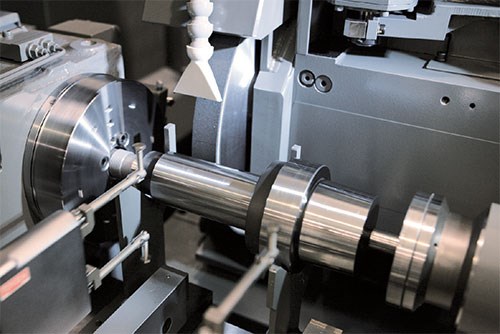Labor Savings in Grinding
Representatives of a grinding equipment supplier comment on how this critical process can be made more efficient.
Grinding is a high-stakes process. By the time a production part reaches a grinding machine, generally that part has undergone significant machining already. The part going to a cylindrical grinder, for example, likely has already spent time on a lathe. If something should happen during the grinding step that results in the part being scrapped, then all of that machining investment is lost—the turning as well as the grinding. A vital requirement of grinding is, therefore, to safeguard the value that has already been added to the part.
However, employees able to oversee this high-stakes process are becoming scarce. As difficult as it is to find skilled machining employees in general, finding skilled grinding employees is more difficult still. At the same time, shrinking lead times are driving many companies to bring grinding in-house. Manufacturers that once would have sent grinding work to a contractor now can’t afford the time to coordinate with an outside supplier. That means facilities that have not performed grinding for a long time are ramping back up this capability—and seeking those scarce employees.
Toyoda Machinery USA supplies production grinding machines. The company’s Shane Farrant, national product manager, and Steve Earley, proposal engineering supervisor, routinely help manufacturers respond to these grinding-related developments. They say automation, in some fashion, is typically the way to achieve productive and reliable grinding when skilled labor is in limited supply. In grinding, that automation takes particular forms.
In-process gaging, they say, is one of the most accessible ways to reduce the need for human intervention in the grinding process. While gaging is typically thought of as an inspection tool, in-process gaging on a cylindrical grinding machine is a productivity tool. Automatic gaging of the workpiece, with measurements sent to the grinding machine’s control, allows the machine to respond to measurement trends resulting from the wheel’s changing diameter. With the process changing offsets on its own to maintain consistency, the wheel might not have to be dressed as often, saving both cost and time.
An even more transformative way to think about reducing the need for labor in grinding is with a universal grinding machine, they say. A universal makes it possible to switch between multiple grinding wheels within the same setup. As a result, ID and OD grinding can be performed on the same machine, not only saving time and attention, but also assuring concentricity between these operations. Separate wheels also can be used to combine rough grinding and finish grinding in one cycle on one machine, speeding the grinding process overall. While a CNC universal grinder is expensive relative to simpler machines, the potential for efficiency gain and cost savings is high.
They say one way to improve efficiency that is not the answer in many applications is switching to a more expensive CBN wheel. On hard materials, CBN can save time and effort because the CBN wheel won’t break down as fast as a conventional wheel. Thus, the need for dressing will be reduced. However, the effectiveness of CBN is highly dependent on the workpiece material, a fact that many grinding users don’t sufficiently appreciate. On a soft material that is prone to loading the wheel, the CBN wheel is subject to that same loading. As a result, dressing might be just as frequent with the CBN wheel as with the conventional wheel, albeit now more expensive because the wheel material is CBN.
Related Content
How to Mitigate Chatter to Boost Machining Rates
There are usually better solutions to chatter than just reducing the feed rate. Through vibration analysis, the chatter problem can be solved, enabling much higher metal removal rates, better quality and longer tool life.
Read MoreHow to Successfully Adopt Five-Axis Machining
While there are many changes to adopt when moving to five-axis, they all compliment the overall goal of better parts through less operations.
Read MoreHow to Start a Swiss Machining Department From Scratch
When Shamrock Precision needed to cut production time of its bread-and-butter parts in half, it turned to a new type of machine tool and a new CAM system. Here’s how the company succeeded, despite the newness of it all.
Read MoreVolumetric Accuracy Is Key to Machining James Webb Telescope
To meet the extreme tolerance of the telescope’s beryllium mirrors, the manufacturer had to rely on stable horizontal machining centers with a high degree of consistency volumetric accuracy.
Read MoreRead Next
Increasing Productivity with Digitalization and AI
Job shops are implementing automation and digitalization into workflows to eliminate set up time and increase repeatability in production.
Read MoreIMTS 2024: Trends & Takeaways From the Modern Machine Shop Editorial Team
The Modern Machine Shop editorial team highlights their takeaways from IMTS 2024 in a video recap.
Read MoreInside Machineosaurus: Unique Job Shop with Dinosaur-Named CNC Machines, Four-Day Workweek & High-Precision Machining
Take a tour of Machineosaurus, a Massachusetts machine shop where every CNC machine is named after a dinosaur!
Read More















.jpg;maxWidth=300;quality=90)












